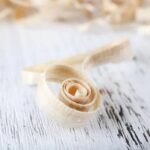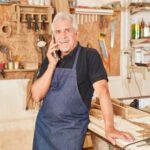Woodworking pegs are essential components in carpentry and joinery, serving as fasteners and structural supports in various woodworking projects. Whether it’s for constructing furniture, building wooden structures, or creating intricate joinery, woodworking pegs play a significant role in ensuring the strength and durability of the finished pieces.
In this article, we will explore the process of making woodworking pegs, from selecting the right wood to the final finishing touches. Additionally, we will discuss the tools and materials needed for crafting these pegs and provide insights into common mistakes to avoid when working on such projects.
The types of wood used for crafting woodworking pegs vary depending on the specific requirements of the project. Different wood species offer unique characteristics such as strength, durability, and aesthetics. Understanding these attributes is crucial in selecting the right wood for creating sturdy and visually appealing pegs. By delving into the world of woodworking pegs, beginners and experienced craftsmen alike can gain valuable knowledge about this fundamental element in woodworking.
Crafting woodworking pegs requires specific tools and materials to ensure precision and quality. From selecting high-quality wood to using hand tools or a lathe for shaping, each step contributes to the overall craftsmanship of the finished product.
For those eager to try their hand at creating their own woodworking pegs, understanding the essential tools and materials needed is crucial for successful execution. Join us as we embark on a journey into the art of making woodworking pegs-an indispensable skill for any woodworking enthusiast.
Tools and Materials Needed
When it comes to making woodworking pegs, having the right tools and materials is essential for a successful project. Whether you are a seasoned woodworker or just starting out, having the proper equipment and supplies will make the crafting process much smoother. Here, we will discuss the tools and materials needed to create quality woodworking pegs.
Essential Tools
The essential tools for making woodworking pegs include a saw for cutting the wood to size, carving tools for shaping the peg, sandpaper for smoothing the surface, and a drill for creating holes if necessary. It’s important to have sharp and high-quality tools to ensure precision and ease of use during the crafting process.
Quality Wood
In addition to tools, having access to quality wood is crucial for crafting sturdy and durable woodworking pegs. While hardwoods like oak, maple, or cherry are commonly used for their strength and durability, softwoods like pine or cedar can also be suitable depending on the specific project requirements. Sourcing wood from reputable suppliers or local lumberyards is recommended to ensure that the material is of good quality.
Tips for Sourcing Materials
For those looking to source their own materials for making woodworking pegs, it’s beneficial to visit local lumberyards or specialty wood stores that offer a variety of wood types in different sizes and shapes. Additionally, some woodworkers may opt to repurpose scrap pieces of wood from previous projects as an eco-friendly and cost-effective option for crafting pegs.
By having the right tools and quality materials at hand, individuals can embark on their journey of creating custom woodworking pegs that meet their specific needs and preferences. With attention to detail and precision using these resources provides anyone with all they need within reach in order to complete this project successfully.
Selecting the Right Wood
When it comes to making woodworking pegs, selecting the right wood is crucial for the success of your project. The type of wood you choose will determine the durability, strength, and aesthetic appeal of your pegs. In this section, we will discuss the different wood types suitable for making woodworking pegs and the importance of choosing the right wood for your specific project.
Exploring Different Wood Types
There are several types of wood that are commonly used for crafting woodworking pegs. Hardwoods such as oak, maple, cherry, and walnut are popular choices due to their strength and durability. Softwoods like pine and cedar can also be used for pegs, especially in projects where a more rustic or natural look is desired. Each type of wood has its own unique characteristics and working properties, so it’s important to carefully consider which type will best suit your needs.
Importance of Choosing the Right Wood
Selecting the right wood for your woodworking pegs is essential to ensure that they can effectively withstand the demands of joinery and construction projects. The chosen wood should be able to hold up under pressure and resist wear and tear over time.
Additionally, considering the visual appearance of the wood is important if aesthetics play a significant role in your project. By carefully choosing the right wood for your woodworking pegs, you can ensure that they not only serve their functional purpose but also contribute to the overall beauty of your finished work.
Cutting and Shaping the Peg
When it comes to making woodworking pegs, one of the crucial steps in the process is cutting and shaping the peg. The first thing you need to do is select a suitable wood for your peg. Common types of wood used for crafting pegs include oak, ash, maple, and walnut. Each type of wood has its own unique characteristics, so it’s important to choose one that suits your specific project needs.
Once you have chosen the right wood for your peg, it’s time to cut it to the desired length. This can be done using a handsaw or a power saw, depending on your preference and the tools available to you.
After cutting the wood to size, you will need to shape it into the desired form for your peg. This can be achieved using hand tools such as chisels and rasps, or with the use of a lathe for more intricate designs.
It’s important when shaping the peg to pay close attention to detail and ensure that the dimensions are uniform across all sides. This will contribute to a more professional-looking finished product. Once you have shaped your woodworking peg, you can move on to smoothing and finishing it in preparation for use in joinery projects or other applications.
| Tools | Materials |
|---|---|
| Handsaw or power saw | Quality wood (e.g. oak, ash) |
| Chisels and rasps | Sandpaper |
| Lathe (optional) | Wood finish (e.g. varnish) |
Smoothing and Finishing
After cutting and shaping the woodworking peg to the desired form, it is essential to focus on smoothing and finishing the surface. This step is crucial to ensure that the peg fits seamlessly into its intended slot while also enhancing its appearance. Here are some tips for achieving a smooth finish and applying the right coating to your woodworking peg:
- Sanding: Start by using a medium-grit sandpaper to smooth out any rough edges or imperfections on the surface of the peg. Once the surface feels even, switch to a finer-grit sandpaper for a smoother finish. Consider using sanding blocks or sanding sticks to maintain uniformity in the shape of the peg.
- Applying a Finish: Once the woodworking peg has been sanded down to a smooth surface, it’s time to apply a finish for protection and aesthetics. There are various options for finishes, including wood oils, varnishes, or even simple wax coatings. Each type of finish offers unique benefits in terms of protection and appearance, so consider the specific needs of your project when selecting a finish.
- Alternative Finishing Techniques: In addition to traditional finishes, you can explore alternative techniques such as burning or staining the wood to achieve different aesthetic effects. Wood burning can create intricate designs on the peg’s surface, while stains can enhance or alter the natural color of the wood.
By paying attention to these details during this process, you will be able to create beautifully crafted woodworking pegs that not only serve their practical purpose but also add an aesthetically pleasing touch to your carpentry and joinery projects. Now that you have learned how to make a woodworking peg smoothly finished with adding fantastic touches let me provide you with some bonus tips that may help:
- The best time-saving technique I have found for making consistent dowels is drilling them out with a drill bit in bulk from square stock (or rectangular) close to size before putting them into your dowel plate – then reaming them through like normal but only needing light pressure.
- When I need many identical lengths at once across several pieces of stock, I find putting stops onto my workbench legs clamps closer towards myself helpful for speed cutting off multiple ends without much measuring each time by hand.
- Unpleasant woods like cocobolo (for their dust/irritant content) can be turned/burnished ‘wet’ using thin superglue (CA) as they’re safer after tension-break polymerized firmly solid are less likely irritating/dust problems later on.
Joinery and Applications
Woodworking pegs play a crucial role in various joinery techniques and applications within carpentry and woodworking projects. The use of woodworking pegs allows for the creation of strong and visually appealing joints in furniture making, construction, and other woodworking endeavors. Understanding how to make a woodworking peg is essential for craftsmen who prioritize traditional joinery methods and seek to enhance the durability and aesthetics of their creations.
In selecting the right wood for crafting woodworking pegs, it is important to consider the specific requirements of the project. Hardwoods such as oak, maple, and cherry are popular choices due to their strength and resistance to wear and tear. For projects where flexibility is needed, softer woods like pine or cedar may be preferred. The key is to select a wood type that aligns with the intended application of the peg while also considering its visual appeal once finished.
Crafting a woodworking peg involves precise cutting and shaping techniques. Once the appropriate wood is chosen, the next step is to cut it into the desired length for the peg. This can be achieved using hand saws or power tools depending on individual preference and available resources.
Then, shaping the wooden piece into the desired form can be accomplished through hand carving techniques or by using a lathe for more intricate designs. Regardless of the method chosen, attention to detail is essential in ensuring that the woodworking peg meets the necessary specifications for its intended use.
Common Mistakes to Avoid
When it comes to making woodworking pegs, there are a few common mistakes that beginners often make. By being aware of these errors and learning how to avoid them, you can ensure a successful woodworking peg project. Here are some of the most common mistakes to watch out for:
1. Using the wrong type of wood: One of the most common mistakes when making woodworking pegs is using the wrong type of wood. Different projects require different types of wood, and using a soft or weak wood for a load-bearing peg can lead to structural issues. It’s important to select hardwoods such as oak, maple, or cherry for strong and durable pegs.
2. Incorrect shaping and sizing: Another mistake that beginners often make is improper shaping and sizing of the peg. Whether you’re cutting the wood by hand or using a lathe, it’s crucial to follow precise measurements and shapes according to your project’s requirements. Failing to do so can result in ill-fitting or weak pegs that won’t serve their intended purpose.
3. Rushing the finishing process: A smooth and well-finished woodworking peg not only looks better but also performs better over time. One common mistake is rushing through the smoothing and finishing process, resulting in rough edges or an uneven surface on the peg. Taking the time to sand and polish the peg will ensure a professional-looking finish that enhances both aesthetics and functionality.
To avoid these common mistakes when making woodworking pegs, it’s essential to carefully select the right wood, pay attention to shaping and sizing details, and take your time with smoothing and finishing. By doing so, you can create high-quality woodworking pegs that will serve their purpose effectively in your carpentry and joinery projects for years to come.
Maintenance and Care
Woodworking pegs are essential components in carpentry and joinery projects, providing structural support and stability to various wooden structures. To ensure the longevity of these pegs, proper maintenance and care are necessary. This section will provide guidelines and tips for maintaining woodworking pegs, preserving their quality and appearance over time.
One of the key aspects of maintaining woodworking pegs is to protect them from moisture and environmental elements. Excessive exposure to moisture can lead to wood rot and decay, compromising the integrity of the pegs. Therefore, it is crucial to store woodworking pegs in a dry, well-ventilated area when not in use. Additionally, applying a protective coating or sealant to the pegs can help prevent moisture absorption and prolong their lifespan.
Regular inspection of woodworking pegs is also important for detecting any signs of damage or wear. Checking for cracks, splits, or any other forms of deterioration is essential in identifying issues early on. In the event that damage is spotted, prompt repairs or replacements should be carried out to maintain the structural integrity of the pegs.
Furthermore, it is advisable to clean woodworking pegs periodically to remove dirt, debris, and any build-up that may occur over time. This can be done using a soft cloth or brush to gently wipe away particles without causing abrasions or scratches on the surface of the pegs.
Proper maintenance and care for woodworking pegs not only extend their lifespan but also contribute to the overall quality and performance of carpentry and joinery projects in which they are utilized.
| Maintenance Tips | Care Recommendations |
|---|---|
| Protect from moisture | Store in dry area |
| Regular inspection for damage | Prompt repairs if needed |
| Cleaning periodically | Use soft cloth/brush |
Conclusion
In conclusion, woodworking pegs are essential components in carpentry and joinery projects, providing strength and stability to various constructions. The process of making woodworking pegs requires careful selection of the right wood, proper cutting and shaping techniques, as well as attention to smoothing and finishing details. By following the steps outlined in this article, individuals can create their own high-quality woodworking pegs that will be suitable for a variety of joinery techniques and applications.
The selection of the appropriate wood for crafting woodworking pegs is crucial, as it directly impacts the strength and durability of the finished product. When choosing the wood, consider factors such as hardness, grain pattern, and suitability for the specific project at hand. Taking the time to source quality wood will ultimately yield better results in terms of both functionality and aesthetics.
Furthermore, by gaining a better understanding of how to make a woodworking peg through this comprehensive guide, readers can enhance their woodworking skills and expand their crafting capabilities. Experimenting with different wood types, cutting techniques, and finishing processes will not only result in finely crafted pegs but also provide valuable hands-on experience for future woodworking projects.
Therefore, we encourage our readers to embark on their own woodworking peg-making journey and discover the satisfaction that comes with creating custom-made pieces for their joinery needs.
Frequently Asked Questions
What Is the Process Used to Make a Wooden Peg?
The process used to make a wooden peg involves shaping a piece of wood into a cylindrical shape with one end pointed or tapered. This can be done using a lathe or other woodworking tools, and may also involve sanding and smoothing the surface of the peg to remove any roughness or splinters.
What Is the Best Wood for Wooden Pegs?
The best wood for wooden pegs is typically hardwoods such as oak, maple, or hickory. These types of wood are strong, durable, and less likely to splinter or break during use. Hardwoods also have natural oils that help protect the wood from moisture and decay, making them ideal for outdoor use.
What Wood Is Used to Make Clothes Pegs?
Clothes pegs are commonly made from softer woods such as beech, birch, or pine. These woods are easier to work with and are less likely to damage delicate fabrics when used for hanging laundry. Softwood clothes pegs may need to be replaced more frequently than hardwood pegs due to their susceptibility to wear and tear over time.

Hi everyone! I’m a woodworker and blogger, and this is my woodworking blog. In my blog, I share tips and tricks for woodworkers of all skill levels, as well as project ideas that you can try yourself.





